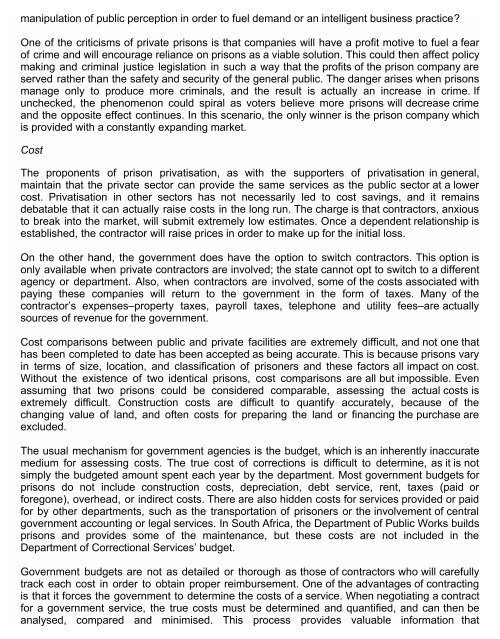prison privatisation in south africa issues, challenges and ...
prison privatisation in south africa issues, challenges and ...
prison privatisation in south africa issues, challenges and ...
Create successful ePaper yourself
Turn your PDF publications into a flip-book with our unique Google optimized e-Paper software.
manipulation of public perception <strong>in</strong> order to fuel dem<strong>and</strong> or an <strong>in</strong>telligent bus<strong>in</strong>ess practice?<br />
One of the criticisms of private <strong>prison</strong>s is that companies will have a profit motive to fuel a fear<br />
of crime <strong>and</strong> will encourage reliance on <strong>prison</strong>s as a viable solution. This could then affect policy<br />
mak<strong>in</strong>g <strong>and</strong> crim<strong>in</strong>al justice legislation <strong>in</strong> such a way that the profits of the <strong>prison</strong> company are<br />
served rather than the safety <strong>and</strong> security of the general public. The danger arises when <strong>prison</strong>s<br />
manage only to produce more crim<strong>in</strong>als, <strong>and</strong> the result is actually an <strong>in</strong>crease <strong>in</strong> crime. If<br />
unchecked, the phenomenon could spiral as voters believe more <strong>prison</strong>s will decrease crime<br />
<strong>and</strong> the opposite effect cont<strong>in</strong>ues. In this scenario, the only w<strong>in</strong>ner is the <strong>prison</strong> company which<br />
is provided with a constantly exp<strong>and</strong><strong>in</strong>g market.<br />
Cost<br />
The proponents of <strong>prison</strong> <strong>privatisation</strong>, as with the supporters of <strong>privatisation</strong> <strong>in</strong> general,<br />
ma<strong>in</strong>ta<strong>in</strong> that the private sector can provide the same services as the public sector at a lower<br />
cost. Privatisation <strong>in</strong> other sectors has not necessarily led to cost sav<strong>in</strong>gs, <strong>and</strong> it rema<strong>in</strong>s<br />
debatable that it can actually raise costs <strong>in</strong> the long run. The charge is that contractors, anxious<br />
to break <strong>in</strong>to the market, will submit extremely low estimates. Once a dependent relationship is<br />
established, the contractor will raise prices <strong>in</strong> order to make up for the <strong>in</strong>itial loss.<br />
On the other h<strong>and</strong>, the government does have the option to switch contractors. This option is<br />
only available when private contractors are <strong>in</strong>volved; the state cannot opt to switch to a different<br />
agency or department. Also, when contractors are <strong>in</strong>volved, some of the costs associated with<br />
pay<strong>in</strong>g these companies will return to the government <strong>in</strong> the form of taxes. Many of the<br />
contractor’s expenses–property taxes, payroll taxes, telephone <strong>and</strong> utility fees–are actually<br />
sources of revenue for the government.<br />
Cost comparisons between public <strong>and</strong> private facilities are extremely difficult, <strong>and</strong> not one that<br />
has been completed to date has been accepted as be<strong>in</strong>g accurate. This is because <strong>prison</strong>s vary<br />
<strong>in</strong> terms of size, location, <strong>and</strong> classification of <strong>prison</strong>ers <strong>and</strong> these factors all impact on cost.<br />
Without the existence of two identical <strong>prison</strong>s, cost comparisons are all but impossible. Even<br />
assum<strong>in</strong>g that two <strong>prison</strong>s could be considered comparable, assess<strong>in</strong>g the actual costs is<br />
extremely difficult. Construction costs are difficult to quantify accurately, because of the<br />
chang<strong>in</strong>g value of l<strong>and</strong>, <strong>and</strong> often costs for prepar<strong>in</strong>g the l<strong>and</strong> or f<strong>in</strong>anc<strong>in</strong>g the purchase are<br />
excluded.<br />
The usual mechanism for government agencies is the budget, which is an <strong>in</strong>herently <strong>in</strong>accurate<br />
medium for assess<strong>in</strong>g costs. The true cost of corrections is difficult to determ<strong>in</strong>e, as it is not<br />
simply the budgeted amount spent each year by the department. Most government budgets for<br />
<strong>prison</strong>s do not <strong>in</strong>clude construction costs, depreciation, debt service, rent, taxes (paid or<br />
foregone), overhead, or <strong>in</strong>direct costs. There are also hidden costs for services provided or paid<br />
for by other departments, such as the transportation of <strong>prison</strong>ers or the <strong>in</strong>volvement of central<br />
government account<strong>in</strong>g or legal services. In South Africa, the Department of Public Works builds<br />
<strong>prison</strong>s <strong>and</strong> provides some of the ma<strong>in</strong>tenance, but these costs are not <strong>in</strong>cluded <strong>in</strong> the<br />
Department of Correctional Services’ budget.<br />
Government budgets are not as detailed or thorough as those of contractors who will carefully<br />
track each cost <strong>in</strong> order to obta<strong>in</strong> proper reimbursement. One of the advantages of contract<strong>in</strong>g<br />
is that it forces the government to determ<strong>in</strong>e the costs of a service. When negotiat<strong>in</strong>g a contract<br />
for a government service, the true costs must be determ<strong>in</strong>ed <strong>and</strong> quantified, <strong>and</strong> can then be<br />
analysed, compared <strong>and</strong> m<strong>in</strong>imised. This process provides valuable <strong>in</strong>formation that
















